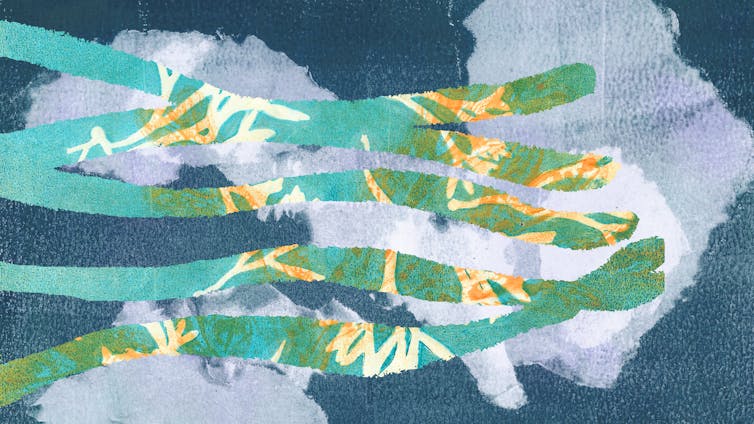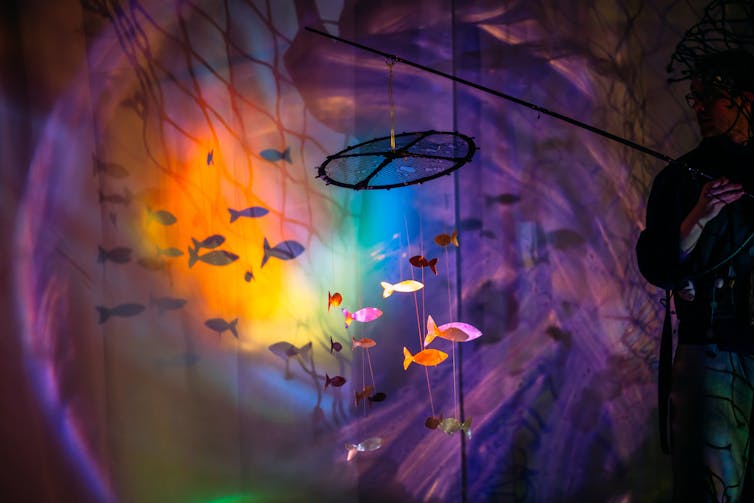In the vibrant ebb and flow of Glasgow’s Byres Road, a new residency of snorkelling artists shines a light on the hidden deep. Until April 24, The Alchemy Experiment, a visual arts and culture venue, is showcasing this thought-provoking exhibition that combines ocean connection with artistic creation.
In collaboration with community group Argyll Coast and Islands Hope Spot, nine artists were invited to take part in a snorkelling artists’ residency that began underwater. This exhibition showcases their diverse range of multimedia artworks, from illustration and printmaking to audio recordings of underwater seascapes and animation.

Designer Renuka Ramanujam’s striking abstract representations of moving seaweed fronds evoke a sensory effect as the layered textures seem so tactile. Installation artist Vicki Fleck’s work uses a variety of media while “exploring the fluid, spongy and colourful landscape” underwater. She says she has been particularly inspired by the horizonless perspective of the snorkeller, “where everything comes up and towards”.
Expert snorkeller Lottie Goodlet shares her incredible knowledge of the seaweeds of Argyll, using this to create beautiful and delicate pressings of seaweeds into artworks, capturing their unique colours and intricate forms.

Internationally acclaimed wildlife artist and scientific illustrator Rachel Brooks’s detailed ink pieces capture the often-overlooked marine life found in UK coastal waters, while drawing on her expertise in zoology and marine biology.

This residency has also inspired poems and storytelling, exhibited with QR codes that direct people to podcasts and compositions by some participants. Fergus Hall, one half of the duo Long Green Jaws (with artist and musician Sarah McWhinney), uses elements of improvised electronic music and analogue visuals to create immersive performances. Composer and sound artist Nicolette MacLeod creates work that invites people to listen to a series of compositions and podcast episodes made in response to the residency experience.
Hope spots
Spearheaded by global initiative Mission Blue, “hope spots” are community action groups that aim to protect marine environments in the face of threats such as climate change, pollution and overfishing. The goal is to create a global network of hope spots, as far flung as the Galápagos and the Great Barrier Reef, that together help protect the hugely unexplored, yet fragile, ocean habitats beneath the waves.
The Argyll Coast and Islands Hope Spot, on the west coast, is the first in Scotland and the only designated hope spot in UK coastal waters. In 2021, the group started holding annual snorkelling-artist residencies to encourage artists to explore and document the incredible hidden world beneath Argyll’s waters.

These residencies give artists access to new pastures of inspiration and discovery. By collaborating with marine scientists during this experience, the artists are encouraged to bring the mysteries and beauty of the largely unseen underwater worlds to a larger public. This can enlighten and educate people about the critical role that the ocean and its teeming-yet-threatened populations play in our own survival.
Visual storytelling
Since the dawn of humanity, people have been recording our environment and the species we interact with, whether in cave paintings or in the detailed and sometimes outlandish renditions by early explorers.
Using visual narratives to communicate information can help demystify and explain sometimes complex, inaccessible and unfathomable places and lifeforms that most people would not normally have access to, or knowledge of.
Visual narratives have a potency that supersedes textual formats. A visual rendition of something is more likely to leave a retained, experiential memory in the viewer that’s more easily recalled than lines of text in a book.

This is why scientists often work with artists, designers and animators to extrapolate complex and multifaceted theories, concepts and ideas. This form of storytelling presents information, data and ideas in a more accessible, visual context that allows more people to see the bigger picture.
In the context of climate change, marine conservation and oceanography, art can communicate findings and encourage participation in a more emotionally engaging way than mainstream news ever could.
Oceans are often seen as impenetrable. It can be hard for people to connect with the sea other than by looking out over its seemingly endless surface. But art initiatives can unite people to engage with causes that might otherwise escape their notice, because visual storytelling brings this subject matter closer to home.
Elsewhere in the world, artist Jason deCaires Taylor and his team create beautiful, figurative sculpture museums that are installed underwater in places such as Mexico, Cyprus and Australia. Over time, these submerged structural artworks slowly morph into artificial reefs, and a transformation happens as they begin teeming with marine life and become part of the ecosystem.
Back on Byres Road, the experience is one of quiet reflection at the myriad ways the ocean and its ecosystems resonate with us. By first noticing, then caring about and protecting life underwater – with the help of more artistic efforts like these – the tide will hopefully soon turn in the preservation of the oceans’ precious habitats.

